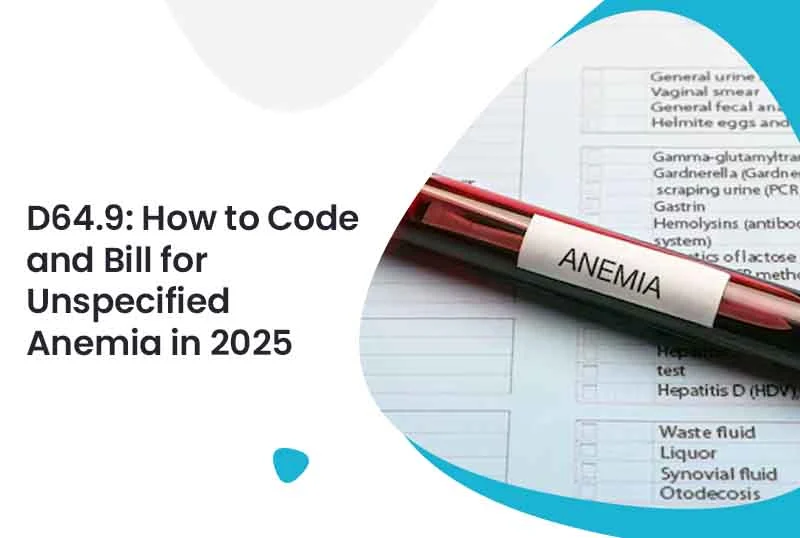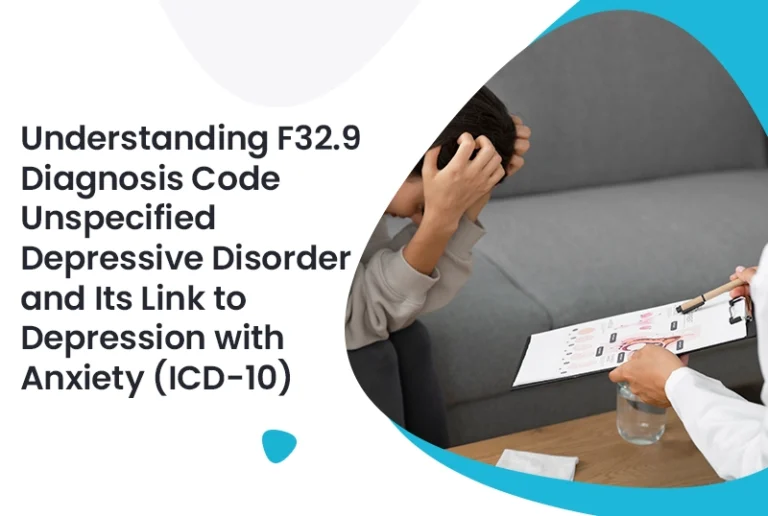Among the most often diagnosed conditions observed in both outpatient and inpatient environments is anemia. D64.9 Anemia, Unspecified is the go-to ICD-10 classification, though, till the precise form of anemia is yet unknown. Whether your role is medical coder, part-time provider, clinic member, or solo provider, timely reimbursement and clean claim submission depend on knowing how to appropriately use D64.9.
In 2025, medical billing services for small practices are seeing a rise in anemia-related claims, especially tied to chronic fatigue and routine bloodwork. If your practice serves older adults or chronic disease patients, chances are high you’ve encountered this code. But how do you code, document, and bill it right?
Let’s break it all down.
What is ICD-10 Code D64.9?
ICD-10 Code D64.9 refers to “Anemia, Unspecified.” This is used when a patient is found to be anemic, but the exact cause whether iron-deficiency, chronic disease, or B12 deficiency — is not yet known.
Common Symptoms That Trigger D64.9 Usage:
- Fatigue and generalized weakness
- Dizziness or light-headedness
- Shortness of breath with mild activity
- Pale skin or cold hands and feet
Clinical Scenarios for Use:
- Initial visits with symptoms pointing to anemia
- Awaiting lab results to confirm anemia subtype
- Elderly patients with chronic low hemoglobin
Best Practice Tip: Document signs and symptoms clearly while pending further diagnosis. Once the anemia type is confirmed, update the code.
Billing Considerations for D64.9 in 2025
As insurance scrutiny increases, it’s vital to bill anemia codes accurately. While D64.9 is valid, overusing it without justification can lead to denials.
Steps to Ensure Billing Compliance:
- Link symptoms and tests: Always associate the code with relevant lab orders (CBC, Iron, Ferritin, etc)
- Use appropriate modifiers when billing multiple visits for follow-up
- Monitor trends: Flag repeat use of D64.9 for patients needing updated workups
If you rely on credentialing services, make sure your provider profile includes internal medicine or specialties that commonly treat anemia this helps prevent issues with claims flagged for scope of practice.
Quick Fact: In 2024, nearly 17% of outpatient claim denials tied to anemia were due to incomplete documentation or improper code use. Don’t let that happen in 2025.
Common Mistakes in Using D64.9
Even experienced coders and providers can misuse the code without realizing it. Here’s what to watch out for.
Avoid These Pitfalls:
- Using D64.9 indefinitely – It’s meant to be temporary until further testing reveals a specific cause.
- Coding anemia without lab support – Always ensure lab results back up the diagnosis.
- Combining D64.9 with more specific anemia codes – This causes redundancy and may trigger audits.
When to Update from D64.9:
Once iron-deficiency, B12-deficiency, or other types are confirmed, switch to:
- D50.9 for iron-deficiency anemia
- D51.0 for vitamin B12 deficiency
- D63.1 for anemia in chronic diseases
Use D64.9 only as a placeholder — never as a long-term code in a patient’s chart.
Role of Credentialing and Documentation
Credentialing isn’t just for hospital privileges. If your practice handles anemia treatment or diagnostics, accurate credentials are vital for payer recognition.
Credentialing services ensure your NPI, taxonomy codes, and provider specialties are up to date across insurers. This becomes crucial when billing for services like:
- In-office hemoglobin tests
- Nutrient injections (e.g., B12 shots)
- Chronic disease management
When payers match your claims to your scope of services, any mismatch can result in claim denial, even if the diagnosis code is correct.
Best Practices for Coding D64.9
The ICD-10 coding landscape is always evolving. Here’s how to stay on track when documenting D64.9 in 2025.
Key Medical Coding Tips:
- Use clear, concise language: Note symptoms and lab orders
- Include test results: Hemoglobin levels, hematocrit, etc.
- Link coexisting conditions: e.g., chronic kidney disease, cancer, or infection.
Many coders make the mistake of using this code too loosely. Good medical coding practices demand that it be backed by detailed progress notes and lab support.
Want cleaner claims? Use EHR templates that prompt for anemia-specific documentation fields.
Conclusion
To sum it up, ICD-10 D64.9 is a valid but temporary diagnosis code for cases of anemia where further workup is pending. In 2025, insurance payers are laser-focused on documentation quality, credential alignment, and specificity in coding.
If you run a small or midsize clinic, don’t overlook the power of good documentation workflows, credential maintenance, and expert medical coding. These simple steps can reduce denials, speed up reimbursements, and make your billing cycle more efficient.
FAQs
Q1: Can I use D64.9 for chronic anemia patients?
Only temporarily. Chronic patients should eventually be assigned a more specific code, such as iron deficiency or anemia of chronic disease.
Q2: How often can I bill D64.9?
Use it only until you confirm the anemia type. Repetitive use without new supporting documentation may lead to audits.
Q3: What documentation is needed to support D64.9?
Symptoms (fatigue, weakness), physical exam notes, and lab test results such as CBC and ferritin levels.
Q4: Can D64.9 be used with other chronic condition codes?
Yes, especially if the anemia is suspected to be related. But update the diagnosis once the cause is confirmed.







